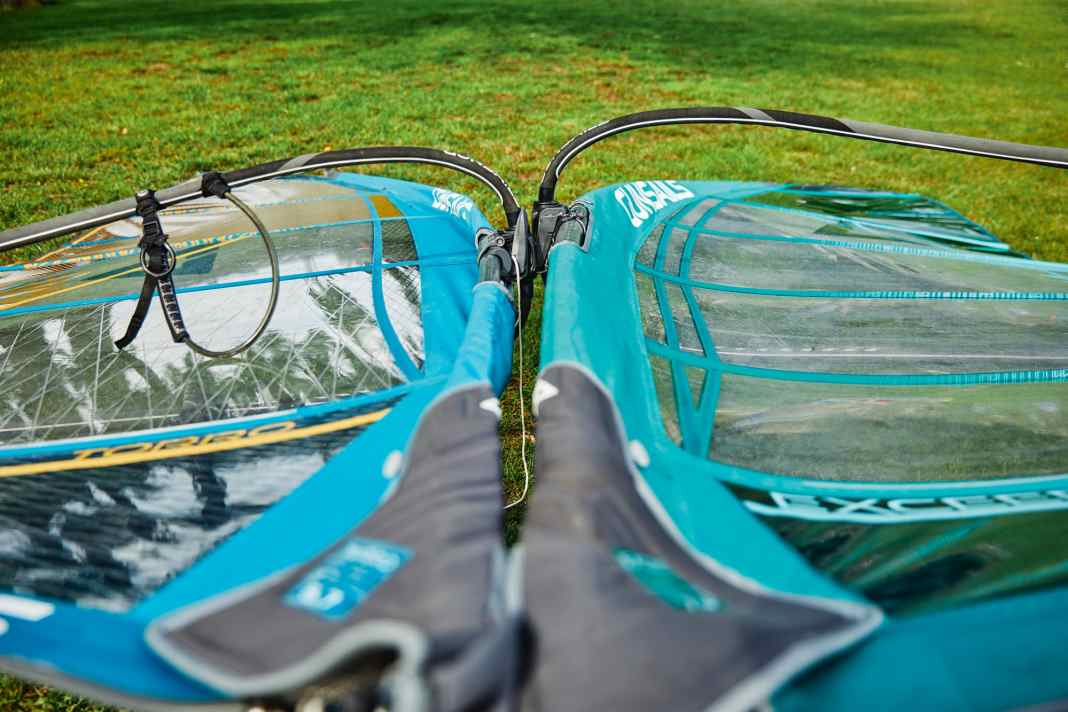





We try to find out how sail designers give their creations the desired characteristics: How does a freemoving sail have to be designed in terms of luff curve, profile depth and trim forces in order to feel as light and playful as possible during manoeuvres? What are the differences to a sporty freeride sail? And what adjustments do developers need to make to turn it into a camber sail optimised for speed and control?
Renato Morlotti, sail designer at GunSails and a very experienced developer, gave us an insight into his daily work. We had the most important terms from sail design in windsurfing explained to us step by step!
In this article:
Luff curve
What the term means: The luff curve describes the extent of the mast bend with which the sail was designed.
What differences you can see: As a rule, the more performance-orientated a sail is designed, the more pronounced the luff curve becomes. A comparison of the three sail types Torro (Freemove), Stream (Freeride) and Exceed (2-Cam Freerace) is a good example of the differences: The Torro gets by with a comparatively small luff curve, which then increases more and more over the Stream model up to the camber sail Exceed. But what are the reasons for this?
What the designer says: "The luff curve has a big influence on how the sail will feel on the water: You have to realise beforehand which mast diameter - SDM or RDM - the sail should work on, in which conditions it will be used and which materials should be used for the construction of the sail. A freemoving sail like the Torro, for example, should be easy to manoeuvre and feel pleasantly damped - this requires the use of a thin and therefore softer RDM mast as well as softer materials, e.g. gridded XPly material in 3-mil thickness and Dacron cloth. I also have to adjust the luff curve accordingly and work with little bend, because a lot of curve would mean that the sail would feel tight, have higher trim forces and the mast would be difficult to thread into the narrow mast pocket of the Torro. The combination of little curve and soft materials in a freemoving sail makes for that light, handy and easy-to-rig concept with low trim forces.
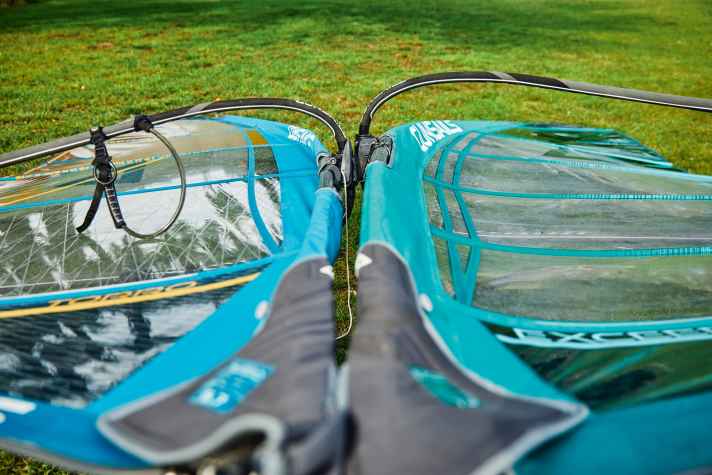
Sails with a low luff curve are also much less problematic when it comes to using the right mast - you can insert virtually any mast from our collection into the Torro (top left in the picture). A freeride sail like our Stream is equipped with more luff curve in comparison. In combination with the use of stiffer materials, the entire sail concept is tighter, which shifts the range of use slightly more towards performance and ensures a more defined profile. The more the luff curve is curved, the better the sail can hold its profile even in strong winds and the more stable the centre of pressure remains.
Consequently, a freerace sail with cambers, e.g. our Exceed model (top right in the picture), must be designed with even more curve. In order to achieve sufficient tension in the profile, we also use stiffer masts with a standard diameter (SDM) for race-orientated sails. We are talking about a few centimetres difference in the luff curve between a freemoving sail and a performance-oriented freeracing sail. That may not sound like much, but in practice it's a world!"
Loose Leech
What the term means:The English term "loose leech" means "loose leech". It refers to the phenomenon that the leech (the rear side of the sail) relaxes the more the sail is trimmed at the luff.
What differences you can see:Freemoving sails generally manage with visibly less loose leech than performance-orientated concepts. For example, when the Torro freemoving sail is trimmed correctly, the creases can only be seen between the top two battens; the rest of the leech is taut (2). On the Exceed camber sail, the creases not only run visibly further forwards to the mast, but almost the entire leech from the top of the sail down to the clew is also relaxed. What is this all about?
What the designer says: "Loose leech has a direct influence on factors such as acceleration, top speed and, above all, control in strong winds. Loose leech can be generated by the extent of the mast bend and also the way in which the individual panels of the sail are sewn. The profile is also created by the fact that the individual panels are not sewn flat, i.e. two-dimensionally, but under tension, so to speak. This allows me to control which areas of the sail receive a lot of tension and which are relaxed. The more loose leech a sail has, the better the sail top can turn away to leeward when surfing, thus releasing excess energy. With freemoving sails like the Torro, my main focus is on early planing and a cushioned ride, which is why I give this model comparatively little loose leech.
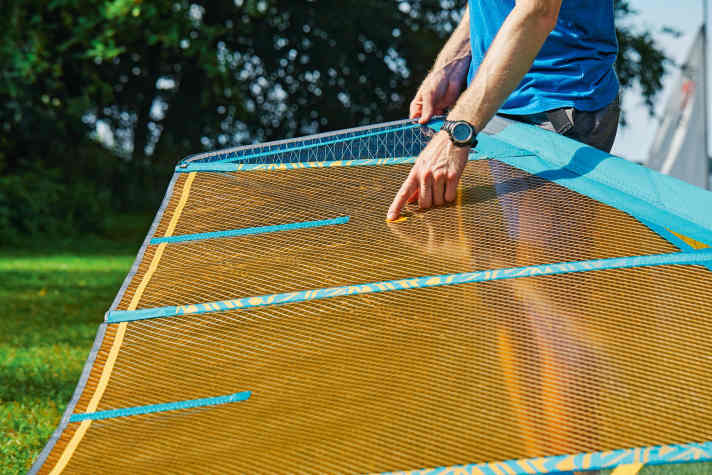
But the more a sail is designed to perform over a wide wind range and in combination with sporty freerace or slalom boards, the more loose leech it will have. For this reason, our models, from the Torro freemove sail to the Stream freeride sail and the camber models, gradually have more and more loose leech. It is important that it remains easy for the end customer to find the right trim. That's why we stick our "FRED" mark on every sail. When trimming the luff, the loose leech should run exactly up to this mark, then everything fits. So now it should be clear why the trim mark on freemoving sails such as the Torro is high up and only about halfway between the mast and leech (see picture above) and on race-orientated sails much further down and in front (3
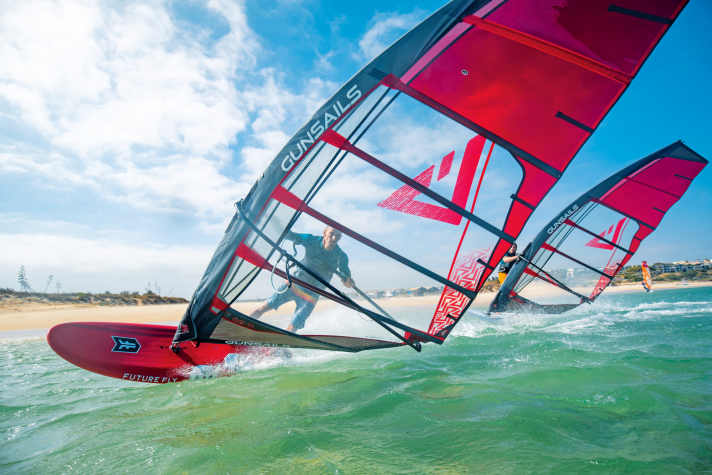
Sail pressure point
What the term means: In simple terms, the "pressure point" can be described as the "centre of force". In a well-tuned rig, the sail's centre of pressure is approximately at head height and between the surfer's hands. The position of the centre of pressure is determined by the shape of the profile.
What differences you can see:You can't see where the pressure point of a sail is, but you can feel it. If you tighten your sail and surf with an even pull on both arms, the pressure point is normally between your hands. If the trapeze ropes are in the right position, you can take the pressure off both arms equally. If you feel a stronger pull on the back hand, for example, this means that the pressure point is behind the centre of the harness ropes - you can correct this by moving the ropes backwards.
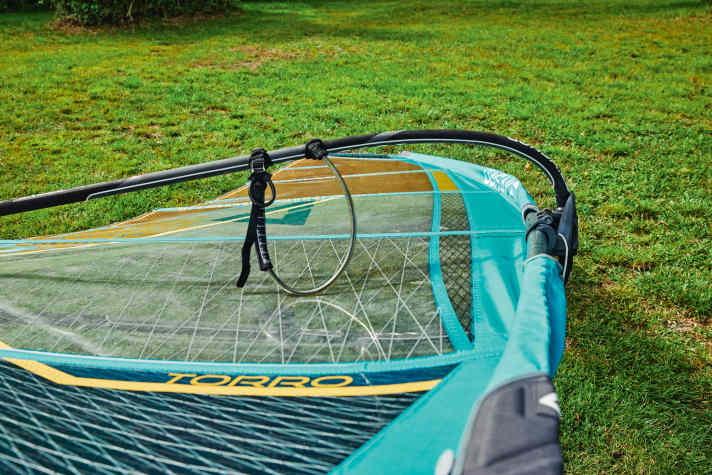
While the exact pressure point position remains hidden on the beach for the time being, the different profiles of the individual sail types are immediately recognisable. Manoeuvre-oriented sail concepts (wave, freemove) have a fairly flat profile. There is only a slight profile in the lower batten, the rest of the battens are often straight as a die in the sail (see picture above). Freeride models such as the Stream are visibly more bulbous in design, the camber models are then strongly reminiscent of an aeroplane wing with a rigidly pre-shaped and deep profile (see picture below). To accommodate the camber, the mast pockets have to be wider. The drawback: water/weight collects here, which makes water launching more difficult compared to camberless sails.
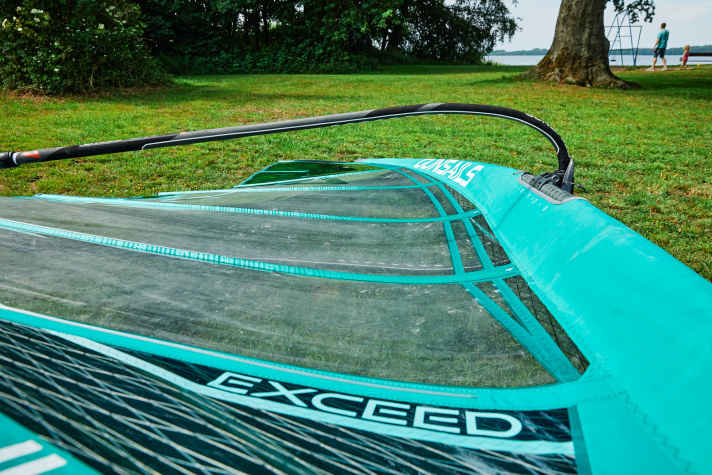
What the designer says:"As I have already indicated, a profile is always created in the sail when the panels are sewn "under tension". This principle is applied both in the horizontal design, i.e. when sewing the individual panels, and in the vertical design when sewing the sail body to the mast sleeve. Sail design is therefore a complex matter. Personally, I always try to ensure that the greatest profile depth and thus the sail pressure point is not too far back, i.e. not to give the sails too much tension on the sail hand. This would put a little more pressure on the fin when planing, but in stronger gusts it would also become uncontrolled more quickly. A pressure point further forwards is more comfortable in this respect and results in good control.
In general, there is relatively little difference in the pressure point position in the transverse direction (between the mast and boom end) if you compare the different models: If you were to switch from a 6.5 freemove sail to a 6.5 2-cam sail, you would hardly have to move the harness ropes on the boom, as the pressure point is almost in the same place. The differences are greater with regard to the pressure point position in the vertical direction: a freemoving sail only has some shape in the lower two battens, so the pressure point here is far down, which benefits manoeuvring. With freeride or even camber sails, the profile extends much further upwards, and the battens only become flat at the top - the pressure point is therefore much higher here.

